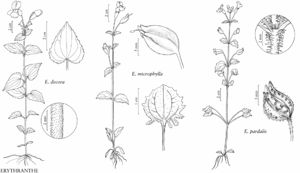Erythranthe pardalis
Phytoneuron 2012-39: 44. 2012.
Annuals, fibrous-rooted or taprooted. Stems decumbent-ascending, erect distally, simple, sometimes branched from proximal to medial nodes, 5–30 cm, short, delicately stipitate-glandular, distals minutely puberulent-glandular, hairs 0.1–0.4 mm (to 1 mm on proximal portions of stems), gland-tipped. Leaves usually cauline, basal usually not persistent; petiole: proximals and medials 8–20 mm, distalmost 1–2 mm; blade palmately 3-veined, usually ovate or broadly ovate to depressed-ovate, proximals and medials 7–22 × 6–18 mm, sometimes largest at mid-stem, base rounded or cuneate to gradually attenuate, margins shallowly dentate-serrate, teeth 2 or 3 (–5) per side mostly distally, apex obtuse to obtuse-acuminate, surfaces sparsely villous to puberulent-glandular, hairs vitreous, gland-tipped, sometimes glabrous. Flowers plesiogamous, 2–12, usually evenly distributed from proximal to distal nodes, chasmogamous, anther pairs in larger corollas slightly separated, stigma at level of distal pair, or both anther pairs and stigma at same level; in smaller corollas without expanded limb and barely exserted beyond calyx margin, both anther pairs and stigma at same level. Fruiting pedicels 10–35 mm, short, delicately stipitate-glandular, distals minutely puberulent-glandular, hairs 0.1–0.4 mm, gland-tipped. Fruiting calyces nodding 45–180º, consistently dark purple-spotted, cylindric-campanulate, inflated, sagittally compressed, 8–11 mm, glabrous or sparsely puberulent-glandular, sometimes minutely hirtellous, throat closing. Corollas yellow, throat floor sometimes red-spotted, bilaterally symmetric, bilabiate; tube-throat narrowly funnelform to cylindric, 7–10 (–12) mm, exserted 1–3 mm beyond calyx margin; limb expanded 8–12 mm, palate villous. Styles glabrous. Anthers included, glabrous. Capsules included, stipitate, 4–6 mm. 2n = 28.
Phenology: Flowering (Mar–)Apr–May.
Habitat: Crevices of serpentine rock, stony red soils, red clay, among boulders, along streams, ditches, tailings at copper mines.
Elevation: 100–700 m.
Distribution
Calif.
Discussion
The relative constancy of Erythranthe pardalis in morphology suggests that genetic influence from other species is slight. It is recognized by its annual duration and relatively delicate habit, ovate to depressed-ovate leaves toothed mostly on the distal margins, small flowers produced from all nodes (proximal to distal), dark-spotted calyces, and stipitate-glandular cauline and foliar vestiture. While the corolla limbs are distinctly expanded, the tubes are only slightly exserted from the calyx, and flowers apparently are plesiogamous. The epithet pardalis alludes to the dark-spotted calyx.
Plants of Erythranthe pardalis occur primarily on serpentine rocks and soils but also grow on copper tailings at mine sites. The species is known from Amador, Calaveras, El Dorado, Placer, Tehama, and Tuolumne counties. The plants in Tehama County, geographically and ecologically disjunct from the main range, were recorded as growing in basalt crevices.
Selected References
None.
